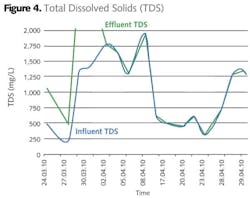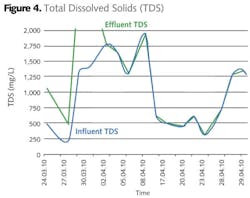Examining water distribution system vulnerabilities
By Dan Kroll and Katy Craig
Introduction
The vulnerability of our distribution systems to disruption and contamination by potential terrorist or malicious acts has been well documented.1,2 These potential attack scenarios have the ability, if orchestrated successfully, to produce casualties on a massive scale. Studies conducted by personnel at Hach Homeland Security Technologies Colorado State University and the U.S. Army Corps of Engineers among others have shown that attacks on drinking water supplies could be mounted for between $0.05 and $5.00 per death, using rudimentary techniques, and could amass casualties in the thousands over a period of hours.3,4,5
The most likely scenario for such an attack, in which the goal is to inflict mass casualties, is to orchestrate a simple backflow contamination event. A backflow attack occurs when a pump is used to overcome the pressure gradient that is present in the distribution system's pipes. This is usually around 80 lbs/in2 and can be easily achieved by using pumps available for rent or purchase at most home improvement stores. After the pressure gradient present in the system has been overcome and a contaminant introduced, siphoning effects act to pull the contaminant into the flowing system. Once the contaminant is present in the pipes, the normal movement of water in the system acts to disseminate the contaminant throughout the network effecting areas surrounding the introduction point. The introduction point can be anywhere in the system such as a fire hydrant, commercial building or residence. See figure 1.
Backflows occur via accident on a regular basis and are of great concern to the water industry. Accidental backflow events have been found to be responsible for many incidents of water borne illness and even death in the United States. According to the USEPA, backflow events caused 57 disease outbreaks and 9734 cases of water borne disease between 1981 and 1998.6
To prevent such accidental backflows many systems have been equipped with backflow prevention devices. These means of preventing backflow are very useful in preventing the all too common accidental event, but it should be noted that these devices are installed to prevent accidental backflows. They are all physical devices that can be removed or disabled quite easily by a would be terrorist thus, rendering them ineffective in preventing deliberate attempts at contamination by all but the most amateurish perpetrators.
Intentional dissemination of contaminants through a backflow event is in fact a very critical vulnerability. Studies conducted by the U.S. Air Force and Colorado State University have shown this to be a highly effective means of contaminating a system.7 These studies show a few gallons of highly toxic material was enough, if injected at a strategic location via the proper method, to contaminate an entire system supplying a population of 100,000 people in a matter of a few hours.
Material and significant contamination was not relegated to only the areas surrounding the introduction point. Material flowed through each neighborhood and then reentered main trunk lines, thus, making its way to the next area until the contaminant had permeated the entire system. Using computer simulations, when a military nerve agent material was used over 20% of the population was determined to have received a dose adequate to result in death and when a common chemical was used in place of the warfare agent the result was a casualty rate of over 10%.
Thousands of deaths could result from this very inexpensive and low-tech mode of attack. There is no doubt that this form of assault meets all of the terrorist's criteria for an attack. It would cause mass casualties, be inexpensive, and actually offer the terrorists a good chance of avoiding apprehension. Unfortunately, because monitoring for contamination in the distribution system typically is limited to infrequent grab samples, the first indications of such an attack are likely to be casualties showing up at local hospitals. A terrorist could launch such an attack and be on a plane out of the country before the first casualty is reported.
These sorts of attacks can occur from any access point to the water system. Wherever water can be drawn out, material can be forced back into the system. Some areas, however, are more vulnerable than others. Access points near high flow areas and larger pipes would be favored because they would disseminate the material to a wider area more quickly, however, any access point except for those at the very end of long deadhead lines could be used to effectively access the system.
It should be obvious from the large number of accidental backflows that occur and the fact that terrorist organizations have shown an interest in attacking water, the distribution system is a prime candidate for such an attack. The fact is a bona fide terrorist is virtually inundated by possible candidate substances and locations that would be very effective in such a role. The possibilities are virtually endless. Protecting against and/or detecting such an attack is difficult.
Recent breakthroughs in the online detection of contaminants have made the deployment of a cost effective early warning system capable of detecting and categorizing such events a reality. The simple truth is that these systems are not widely deployed and, in locations where they are, the ubiquitous nature of potential attack sites makes 100% coverage of the population an effective impossibility until such time as it becomes practical to deploy sensors on every tap.
For information on innovative and award-winning solutions for distribution monitoring, please contact Hach Company or Nicole Bertram, Distribution Monitoring Product Manager at [email protected].
Resources
1 Kroll, Dan. 2006. Securing Our Water Supply: Protecting a Vulnerable Resource. PennWell Publishers. Tulsa, Oklahoma.
2 Hickman, Donald C. 1999. A chemical and biological warfare threat: USAF water systems at risk. Counter Proliferation paper No. 3. USAF Counter Proliferation Center, Air War College.
3 Kroll, Dan. 2003. Mass Casualties on a Budget. Confidential Briefing Paper. Hach HST.
4 U.S. Army Corps of Engineers. n.d. Calculations on threat agents and requirements and logistics for mounting a successful backflow attack.
5 Allman, T.P. 2003. Drinking water distribution system modeling for predicting the impact and detection of intentional contamination. Master's Thesis. Department of Civil Engineering. Colorado State University.
6 USEPA 2002. Potential Contamination Due to Cross-Connections and backflow and the Associated health risks: An Issue Paper. www.eap.gov/ogwdw/tcr/pdf/ccrwhite.pdf
7 Allman, Timothy and Kenneth Carlson. 2005. Modeling Intentional Distribution System Contamination and Detection. Journal of the American Water Works Association. January. Note: that the executive summary of this article is still available but the full text has been pulled from the AWWA website for security reasons as it was determined that the details could be helpful to would be terrorists.
8 EPA. Water Security and You. http://cfpub.epa.gov/safewater/watersecurity/pubs/water-security-article.pdf
About the Authors:
Dan Kroll is chief scientist at Hach Company's Homeland Security Technologies division, in Loveland, CO. He has been the lead researcher on a variety of method development projects for the physical, chemical and microbiological quality of water and soils for which he holds several patents.
Katy Craig is Hach's Director of Water Systems. When Katy first started at Hach Company 17 years ago, she was Clifford Hach's laboratory intern. Since then Katy has been working on teams with Hach scientists and engineers to bring the most reliable water quality products to the drinking water industry. Today she works with Hach Homeland Security Technologies to develop breakthrough technologies. Katy holds a BS Chemistry and BS Biology from Sterling College and MBA from Colorado State University
###

